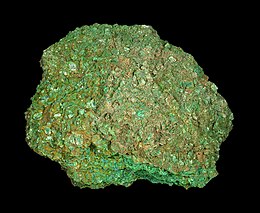| Népouite | |
|---|---|
 Népouite from the Népoui Mine, North Province, New Caledonia. Specimen size: 21 cm. Népouite from the Népoui Mine, North Province, New Caledonia. Specimen size: 21 cm. | |
| General | |
| Category | Phyllosilicates Kaolinite-serpentine group |
| Formula (repeating unit) | Ni3(Si2O5)(OH)4 |
| IMA symbol | Npo |
| Strunz classification | 9.ED.15 |
| Dana classification | 71.1.2b.3 |
| Crystal system | Orthorhombic |
| Crystal class | pyramidal (mm2) (same H-M symbol) |
| Space group | Ccm21 (no. 36) |
| Identification | |
| Color | bright green (typical of nickel bearing silicates) to yellowish or brownish green, depending on nickel content |
| Crystal habit | generally massive, also fibrous and microscopic pseudohexagonal platy crystals |
| Cleavage | perfect on {001} |
| Mohs scale hardness | 2 to 2+1⁄2 |
| Luster | earthy to waxy, also pearly |
| Streak | greenish white |
| Diaphaneity | semitranslucent |
| Specific gravity | 3.18 to 3.24 (measured) |
| Optical properties | biaxial (−) |
| Refractive index | nα = 1.600 – 1.630 nγ = 1.635 – 1.650 |
| Birefringence | 0.035 |
| Pleochroism | weak. X = green to yellow green Z = yellow-green |
| References | |
Népouite is a rare nickel silicate mineral which has the apple green color typical of such compounds. It was named by the French mining engineer Edouard Glasser in 1907 after the place where it was first described (the type locality), the Népoui Mine, Népoui [fr], Poya Commune, North Province, New Caledonia. The ideal formula is Ni3(Si2O5)(OH)4, but most specimens contain some magnesium, and (Ni,Mg)3(Si2O5)(OH)4 is more realistic. There is a similar mineral called lizardite (named after the Lizard Complex in Cornwall, England) in which all of the nickel is replaced by magnesium, formula Mg3(Si2O5)(OH)4. These two minerals form a series; intermediate compositions are possible, with varying proportions of nickel to magnesium.
Pecoraite is another rare mineral with the same chemical formula as népouite, but a different structure; such minerals are said to be dimorphs of each other, in the same way as graphite is a dimorph of diamond. Népouite, lizardite and pecoraite are all members of the kaolinite-serpentine group.
Garnierite is a green nickel ore that formed as a result of weathering of ultramafic rocks, and that occurs in many nickel deposits worldwide. It is a mixture of various nickel and magnesium phyllosilicates (sheet silicates), including népouite. Associated minerals include calcite, chlorite, goethite, halloysite, nontronite, pimelite, quartz, sepiolite, serpentine, talc and willemseite.
As well as the type locality in New Caledonia, it has been found in Australia, Austria, the Czech Republic, the Democratic Republic of Congo, Germany, Greece, Italy, Japan, Morocco, Poland, Russia, South Africa and the United States.
Structure
Space group Ccm21. Unit cell: a = 5.31 Å, b = 9.19 Å, c = 14.50 Å
| d spacing | 7.31 | 4.55 | 3.63 | 2.89 | 2.50 | 2.31 | 2.20 | 1.53 |
|---|---|---|---|---|---|---|---|---|
| relative intensity | 10 | 5 | 9 | 6 | 7 | 4 | 4 | 6 |
See also
- Lizardite – Magnesium phyllosilicate mineral of the serpentine group (Mg3(Si2O5)(OH)4)
- Pecoraite – Nickel phyllosilicate mineral of the serpentine group (Ni3(Si2O5)(OH)4)
- Antigorite – Magnesium-Fe phyllosilicate mineral of the serpentine group ((Mg,Fe)3(Si2O5)(OH)4)
References
- Warr, L.N. (2021). "IMA–CNMNC approved mineral symbols". Mineralogical Magazine. 85 (3): 291–320. doi:10.1180/mgm.2021.43. S2CID 235729616.
- http://rruff.geo.arizona.edu/doclib/hom/nepouite.pdf Handbook of Mineralogy
- http://www.mindat.org/min-2882.html Mindat.org
- http://www.webmineral.com/data/Nepouite.shtml Webmineral data
- M. E. Glaser (1907). "Note sur une espèce minérale nouvelle, la népouite, silicate hydraté de nickel et de magnésie. Bulletin de Minéralogie. Année 1907, 30 (1), pp. 17–28. – Sur le site de Persée" [Note on a new mineral species, népouite, hydrated silicate of nickel and magnesia. Bulletin de Minéralogie. Year 1907, 30 (1), pp. 17–28. – On the Persée website]. persee.fr (in French). Retrieved 28 November 2022.
- "Lizardite-Népouite Series".
- American Mineralogist (1975): 60: 863–871
- Dana’s New Mineralogy, Eighth Edition, 1997, Gaines et al., Wiley.
- Mineralogical Record 38-5, page 384